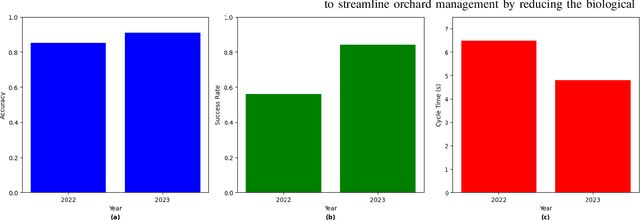Changki Mo
A Robotic System for Precision Pollination in Apples: Design, Development and Field Evaluation
Sep 30, 2024



Abstract:Global food production depends upon successful pollination, a process that relies on natural and managed pollinators. However, natural pollinators are declining due to different factors, including climate change, habitat loss, and pesticide use. Thus, developing alternative pollination methods is essential for sustainable crop production. This paper introduces a robotic system for precision pollination in apples, which are not self-pollinating and require precise delivery of pollen to the stigmatic surfaces of the flowers. The proposed robotic system consists of a machine vision system to identify target flowers and a mechatronic system with a 6-DOF UR5e robotic manipulator and an electrostatic sprayer. Field trials of this system in 'Honeycrisp' and 'Fuji' apple orchards have shown promising results, with the ability to pollinate flower clusters at an average spray cycle time of 6.5 seconds. The robotic pollination system has achieved encouraging fruit set and quality, comparable to naturally pollinated fruits in terms of color, weight, diameter, firmness, soluble solids, and starch content. However, the results for fruit set and quality varied between different apple cultivars and pollen concentrations. This study demonstrates the potential for a robotic artificial pollination system to be an efficient and sustainable method for commercial apple production. Further research is needed to refine the system and assess its suitability across diverse orchard environments and apple cultivars.
Robotic Pollination of Apples in Commercial Orchards
Nov 21, 2023
Abstract:This research presents a novel, robotic pollination system designed for targeted pollination of apple flowers in modern fruiting wall orchards. Developed in response to the challenges of global colony collapse disorder, climate change, and the need for sustainable alternatives to traditional pollinators, the system utilizes a commercial manipulator, a vision system, and a spray nozzle for pollen application. Initial tests in April 2022 pollinated 56% of the target flower clusters with at least one fruit with a cycle time of 6.5 s. Significant improvements were made in 2023, with the system accurately detecting 91% of available flowers and pollinating 84% of target flowers with a reduced cycle time of 4.8 s. This system showed potential for precision artificial pollination that can also minimize the need for labor-intensive field operations such as flower and fruitlet thinning.
 Add to Chrome
Add to Chrome Add to Firefox
Add to Firefox Add to Edge
Add to Edge